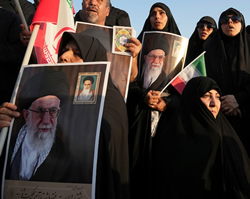As Iranian women protest hijab rules, Tracey Shelton* looks at some of the strictest clothing laws around the world
 The death of a young woman detained by morality police in Iran has sparked protests across the globe.
The death of a young woman detained by morality police in Iran has sparked protests across the globe.
Mahsa Amini, 22, was arrested in Tehran for wearing “unsuitable attire” and died in custody three days later.
Iran is one of only two countries in the world that require women to cover their hair by law.
In rallies that activists say have claimed the lives of more than 80 people, women have burned headscarves and cut their hair in the streets to protest clothing laws imposed on Iranian women.
But there are other countries that impose rules on the way both men and women can dress in public, and it’s not always about religion.
The location of some of the strictest clothing laws in the world might surprise you.
What does the law in Iran say?
Iranian law states that “anyone who explicitly violates any religious taboo in public” should be imprisoned for up to two months, or flogged with 74 lashes.
In practice, this means women must cover their hair with a headscarf and their arms and legs with loose clothing.
According to Amnesty International, authorities “have imposed forced hijab on girls as young as seven years old”.
Most commonly, women deemed to be “unsuitably dressed” are detained until family members bring them appropriate clothing and they sign a statement saying they won’t do it again.
But in some cases women, like Ms Amini, are sent to a “guidance centre” to be taught how to dress appropriately.
The hijab has been compulsory in Iran since the Islamic Revolution in 1979, and in Afghanistan women have also long been subjected to laws and cultural obligations over their attire.
Since the Taliban seized power last year, laws have been tightened once more. In May, a Taliban directive said women should be covered from head-to-toe with only the eyes showing.
This week, Afghan women joined a growing movement across the globe in support of Iranian women.
As police tore their signs and threatened them, they chanted: “Iran has risen, now it is our turn. Death to the dictator whether in Kabul or Tehran.”
Islamic clothing laws apply to men too
While you may be aware of rules regarding women’s dress based on Islamic law, there are rules that apply to men also.
In Afghanistan, men are required to wear Islamic clothes and cap, with beards that extend out to the length of a fist.
In Iran, the same law, which saw Ms Amini detained, has been applied to men for having “western-style” haircuts or clothing styles, although detentions of men under this code are far less common.
In Sudan, prior to 2019, “immoral dress” could be punished with forty lashes, a fine or both.
This was most commonly applied to women for wearing trousers or skirts above the knee, but its interpretation was left up to law enforcement officers.
While the law also applied to men, enforcement was rare. However, in 2010, seven male models were convicted of indecency for wearing make-up.
After the 2019 revolution, the Sovereign Council removed the law, yet its effects on society and the expectations on women’s clothing still linger.
The same can be said of Saudi Arabia, where, in 2018 the requirement for women to wear head coverings and abayas — a long black loose-fitting gown — was overturned.
Women are still required to “dress respectfully”, and Saudi men are also required to keep their shoulders and legs covered with loose-fitted clothing.
While it is women who have borne the brunt of past crackdowns on dress in Saudi Arabia, in some cases men have also been charged.
There have been several reports of men arrested for “cross-dressing” or “dressing like women” in recent years, according to local media reports.
Bizarre clothing restrictions
Most countries have laws to regulate appropriate dress.
In Australia, indecent exposure laws do not prevent women going topless, and breastfeeding in public is a legal right.
However, it is illegal to dress up in black like a cat burglar with black shoe polish on your face, according to Owen Hodge Lawyers of NSW.
The NSW’s crimes act does outlaw having your “face blackened or otherwise disguised … with intent to commit” a crime.
It was only in 2013 that France overturned a 200-year-old ban on women wearing trousers.
If you have ever travelled to Thailand, you may have come across the widespread belief that leaving the house without underwear is against the law.
However, this rule does not seem to appear in Thailand’s current penal code.
Many Caribbean islands have banned wearing any form of camouflage or even carrying items made of camouflage material, according to local travel advisories.
Cultural dress laws in North Korea, Bhutan
While many clothing laws originate from dominant religious beliefs, some stem from other local customs and traditions.
In Bhutan traditional Bhutanese dress — the knee-length wrap-around “gho” for men and the ankle-length dress known as the “kira” for women — was made compulsory outside of the home in 1989.
While the country has gradually relaxed the dress code in recent years, it is still required at school, work and official functions.
There are strict dress codes in North Korea, including harsh penalties recently announced for anyone with a “western style” haircut or wearing skinny jeans.
In 2014, Radio Free Asia reported that male university students were required to get the same haircut as their leader Kim Jong-un.
The ABC was unable to confirm if this is still required today.
Banning modesty
Some western countries have made dressing too conservatively a crime.
Since 2010, France, Denmark, Belgium, Austria, the Netherlands, Bulgaria, Italy, Switzerland and Latvia have introduced various bans on conservative versions of Islamic dress, often referred to as “burqa bans”.
In 2017, China banned the burqa in the largely Islamic state of Xinjiang, and some other Asian as well as African states have also imposed similar bans.
While the reasons cited for such restrictions are usually related to security, these laws have been widely criticised as a violation of religious freedom.
But it’s not just western countries that have banned Islamic dress.
The government of Tajikistan, where 90 per cent of the population identifies as Muslim, passed a law in 2017 that urges Tajiks to “stick to traditional and national clothes” and suggests that women wear their hair uncovered.
Police have used the law to crack down on women’s headscarfs and men’s beards in raids and road blocks.
In Tunisia, the niqab — which covers all but the eyes — was outlawed in 2019, while in Turkey, it wasn’t until 2010 that the government ended a headscarf ban in universities, government buildings and schools.
*Tracey Shelton is a journalist at the ABC’s Asia Pacific Newsroom.
This article first appeared at abc.net.au.











